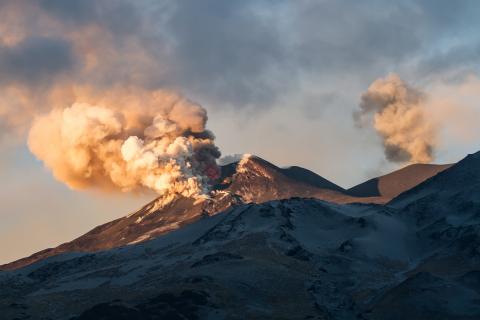Predicting volcanic eruptions – new technique developed by scientists

Scientists from The Open University (OU) have developed a new technique to help predict when a volcano is most likely to erupt based on measurements of how much nearby ground swells.
The ‘inflation’, or gradual swelling, of the ground that often occurs before an eruption, is a well-known phenomenon at many active volcanoes. Through analysing this activity at Krafla volcano in Iceland, a team of scientists from the OU, Edge Hill University, and the University of Edinburgh*, found that the time when eruptions started was closely related to the changing rate of ground swelling, which can be measured ahead of time and therefore used to make forecasts.
Lead author of the new research and Reader in Volcanology at The Open University, Stephen Blake, explains: “A volcano has a system of chambers and tunnels inside. Magma fills these chambers and tunnels making the surface of the volcano gradually expand and swell. The more magma that builds up, the closer the volcano is to exploding. Eventually, the pressure becomes so great that the volcano violently bursts like a popped balloon and an eruption occurs.
“By regularly studying an actively inflating volcano, this new method tells us the percentage chance that the volcano will start erupting during, say, the next week or the next month.”
Although current prediction models aim to provide an exact date a volcano will erupt, the uncertainty in that prediction can be large or isn’t considered. This new method overcomes that by calculating the probability that a volcano will erupt during any given period, and the forecasts can be updated while the volcano is being monitored.
Blake continues: “Like a weather forecast which gives the percentage chance of rain on some day in the future, the method we have developed identifies the probability that an active volcano will erupt during any particular period of time, so that local residents have time to prepare.
“As we know from the Eyjafjallajökull eruption in April 2010, ash clouds from an eruption can rise many kilometres into the atmosphere, which can disrupt air transport. Knowing the probability of a volcanic eruption starting during a given period will help governments and other agencies to plan ahead and reduce disruption to international travel.”
The research, ‘Forecasting deflation, intrusion and eruption at inflating volcanoes’, is published in the journal Earth and Planetary Science Letters.
Quarterly Review of Research
Read our Quarterly Review of Research to learn about our latest quality academic output.

Contact our news team
For all out of hours enquiries, please telephone +44 (0)7901 515891
Contact details